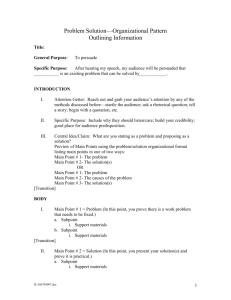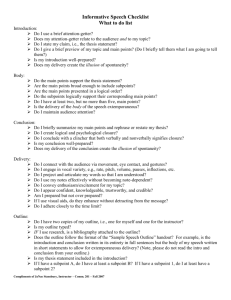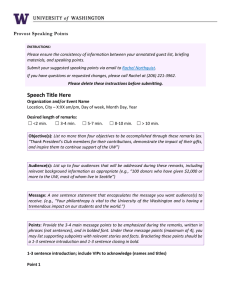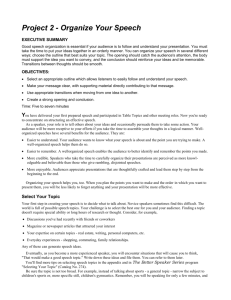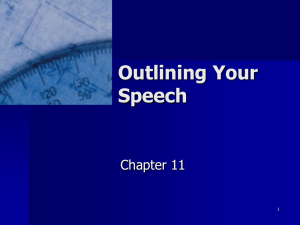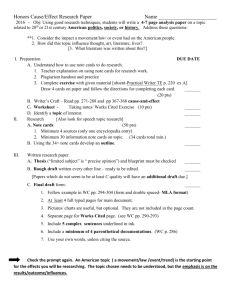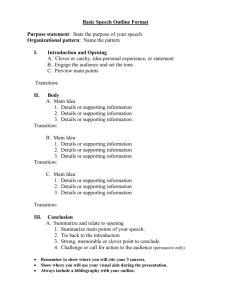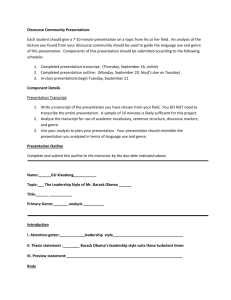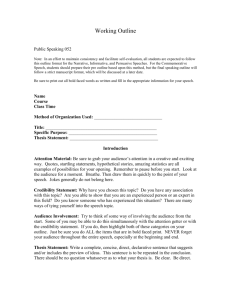Speech #2 – Organize Your Speech
advertisement
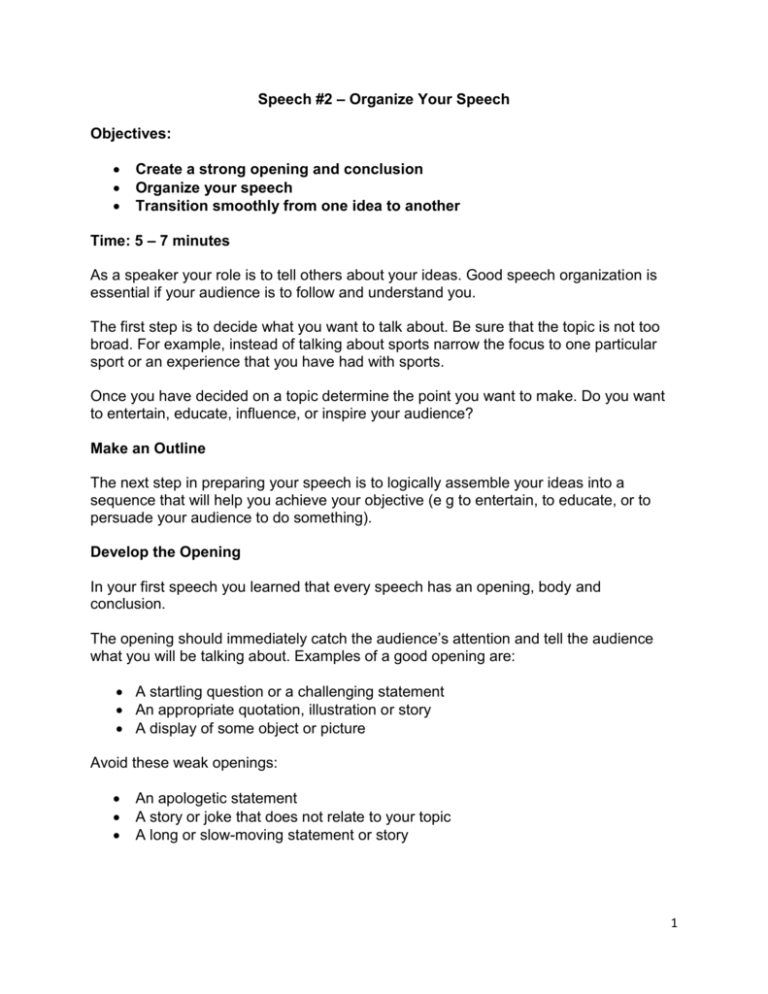
Speech #2 – Organize Your Speech Objectives: Create a strong opening and conclusion Organize your speech Transition smoothly from one idea to another Time: 5 – 7 minutes As a speaker your role is to tell others about your ideas. Good speech organization is essential if your audience is to follow and understand you. The first step is to decide what you want to talk about. Be sure that the topic is not too broad. For example, instead of talking about sports narrow the focus to one particular sport or an experience that you have had with sports. Once you have decided on a topic determine the point you want to make. Do you want to entertain, educate, influence, or inspire your audience? Make an Outline The next step in preparing your speech is to logically assemble your ideas into a sequence that will help you achieve your objective (e g to entertain, to educate, or to persuade your audience to do something). Develop the Opening In your first speech you learned that every speech has an opening, body and conclusion. The opening should immediately catch the audience’s attention and tell the audience what you will be talking about. Examples of a good opening are: A startling question or a challenging statement An appropriate quotation, illustration or story A display of some object or picture Avoid these weak openings: An apologetic statement A story or joke that does not relate to your topic A long or slow-moving statement or story 1 Draft the Body The body is the main part of your speech and consists of the facts or ideas you want to present. The amount of information that you include in the body will be limited by the amount of time available to you and how much the audience can remember. Most listeners will remember only three to five main facts or ideas. For a five-to-seven minute talk, three facts or ideas are plenty. What facts or ideas do you want to get across to your audience? You may find it helpful to write down all of those ideas on small note cards, using one card per idea or fact and one sentence per idea or fact. Then select the three best or most important facts or ideas. Arrange them in the order that will most effectively present your message. For example, if you are writing a speech about the benefits of exercise, the three main points you might select are: 1. Regular exercise helps you sleep. 2. Regular exercise protects against chronic healthy problems associated with aging. 3. Regular exercise is a fun way to meet people. The next step in developing the body of your speech is to elaborate on each main point with subpoints. A subpoint clarifies, emphasizes or proves the idea that it supports. Using subpoints makes the speech more interesting. Supporting material then follows each subpoint. Supporting materials can include: Statistics. These are numerical ways of conveying information about incidents, data and events. Testimony. These are quotes or opinions from people with expertise on the subject. Examples, stories or anecdotes. These usually relate an event that happened to you or someone you know, or someone you have read about. Visual aids. These could be diagrams, charts, pictures, models or other objects. The Conclusion The conclusion is your final opportunity to convey your message and main points in a manner that will help the audience remember them. It should reinforce your ideas and leave listeners with a lasting impression. 2 If you were informing the audience you could conclude with a summary of the ideas presented in the body of the speech. If you were persuading or motivating the audience to take some action, you could suggest a course of action that they could take. Resist the temptation to introduce new ideas in the conclusion. Finish forcefully and confidently. Sample Speech Outline Following is an outline for a speech containing three main points: A. Opening 1. Captures audience attention 2. Leads into speech topic B. Body 1. Main point a. Subpoint b. Support material 2. Main point a. Subpoint b. Support material 3. Main point a. Subpoint b. Support material C. Conclusion 1. Review or summary 2. Call to action or memorable statement Pay Attention to Transitions Audiences need help in moving smoothly from one topic to another. Transitions provide these valuable bridges, helping the audience to follow the ideas being presented and to see the relationship of those ideas. Transitions are usually used as you move. From speech introduction to the body From a main point to a subpoint From a subpoint to support material From support material to another main point From the last support material to the conclusion Transitions can be words, phrases, statements or questions. Some transition words are afterward, also, but, consequently, consider, finally, instead, later, meanwhile, 3 moreover, next, then, yet. Some transitional phrases are: according to, as a result, for example, in addition, let’s begin with, to illustrate. A transitional statement is: “We must consider three things in applying for this new grant money. First is…Second is…Third is…” Your Assignment Your assignment is to use an outline to enable your listeners to easily follow and understand your presentation. Make your message clear using main points, subpoints and support materials. Use appropriate transition words and create a strong opening and conclusion. Source: Adapted from Toastmasters International materials. 4
